If you’re reading this blog, chances are you know what Customer Lifetime Value (CLV) is, and you understand the importance of it. Optimizing for CLV is one of the best moves your brand can make, but without the right strategies in place, improving it can be quite difficult. Once you really understand how CLV works and learn the ins and outs of optimizing for it, it becomes much easier to do. If you want to learn how to increase Customer Lifetime Value, then stick around because this guide is just for you.
What is CLV?
Customer Lifetime Value (CLV) is a metric we use to measure how valuable our average customers are based on how much they spend over their lifetime with a brand. This takes several factors into consideration, such as your Average Order Value (AOV), Purchase Frequency, Margins, Revenue, and Retention Rate. Each one of these components is important to keep track of on its own, but when you combine them to calculate CLV, you can get much more insight than if you were to just look at them individually.
How to Calculate Customer Lifetime Value
The first step to increasing CLV is to first calculate what your current average CLV is for your brand. Once you calculate your CLV, you’ll have a benchmark for success and have a clear goal of where you need to be.
There are a few different variations of the formula used to calculate CLV, but what most brands do is evaluate it based on revenue, not actual profit. It’s important to account for your Cost Of Goods Sold (COGS) when trying to find CLV to get the true value, which is why our formula includes Gross Profit Margin.
Here’s the best formula for calculating Customer Lifetime Value:
((Purchase Frequency x AOV x Gross Profit Margin x Customer Lifespan))
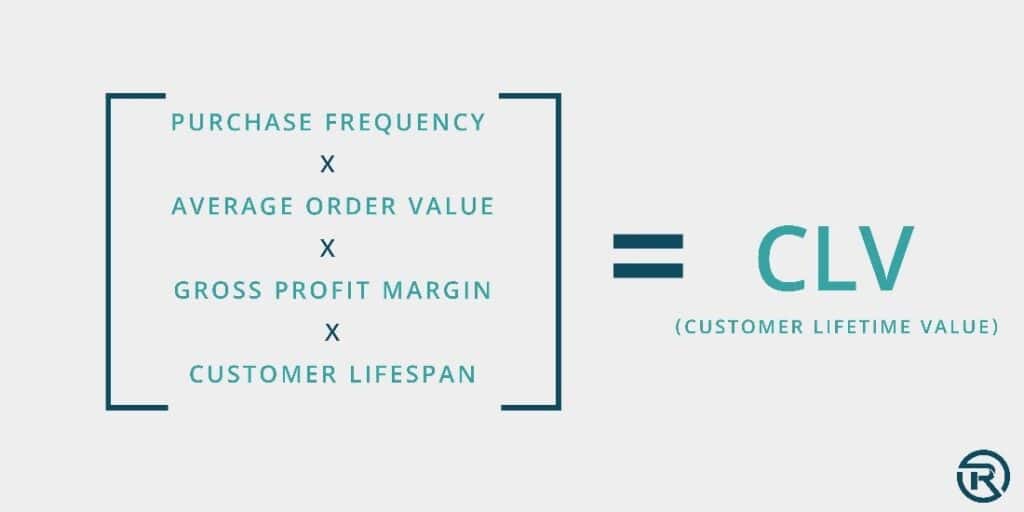
Each one of these variables will need to be further broken down and calculated so you can get the end product and find your CLV.
Calculating Purchase Frequency
Purchase frequency defines how many times your average customer purchases from you over a given timeframe.
Purchase Frequency Formula
# of Orders / # of Customers
To find your average Purchase Frequency, you’ll need to divide the total number of orders by the number of different customers. This will show you the average number of orders each customer places.
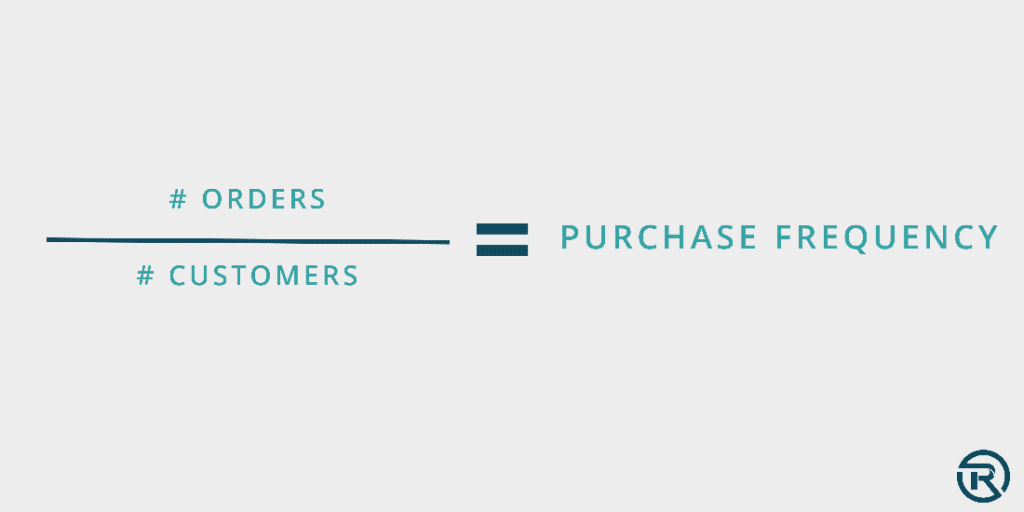
Calculating Average Order Value (AOV)
Average order value is a basic metric that tells you how much your average customer spends on an order.
Average Order Value (AOV) Formula
Total Revenue / # of Orders
Your AOV gives you the average amount a customer spends on a transaction. To find this, you’ll need to divide your Total Revenue by the total number of Orders.
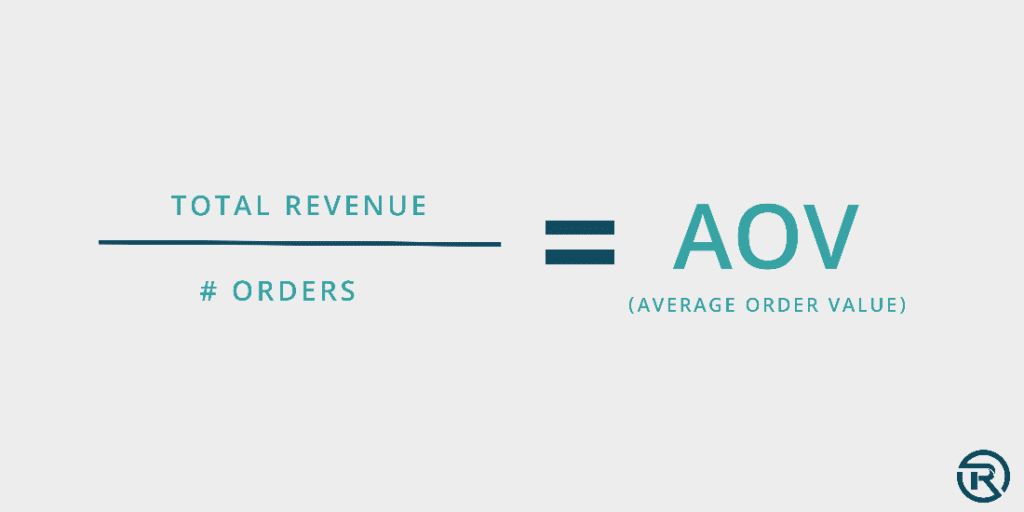
Calculating Gross Profit Margin
Gross Profit Margin is a necessary step in accurately calculating CLV, because it takes into consideration your Cost of Goods Sold. Your AOV tells you how much your average customer spends, but that doesn’t account for your actual profit, just sales.
Gross Profit Margin Formula
((Total Sales – COGS) / Total Sales) x 100
Your Gross Profit Margin tells you what percent of revenue is actually profit. To calculate this, you need to first subtract your Cost of Goods Sold from your Total Revenue. Once you find the difference, you’ll divide that number by your Total Revenue.
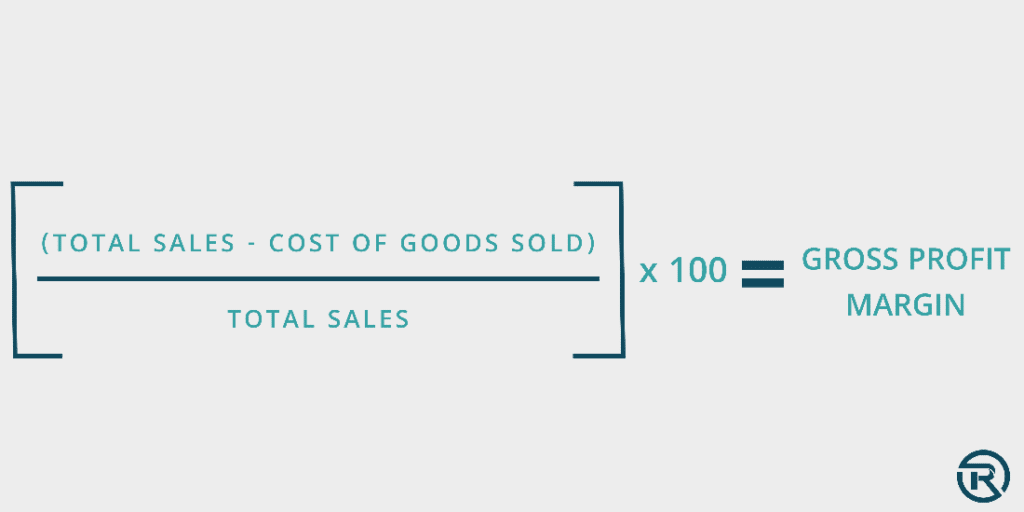
Calculating Customer Lifespan
Finding Customer Lifespan is the final step of the formula. This portion tells you how good your retention is.
Customer Lifespan Formula
1 / 1 – Retention Rate
To find your Customer Lifespan, you need to find your retention rate and subtract it from 1. Then, take that difference and divide it by 1.
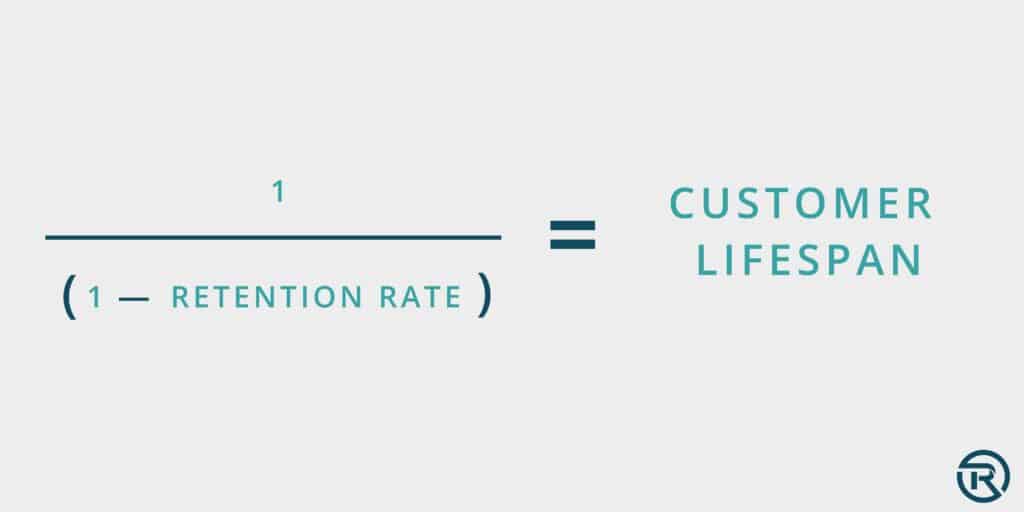
Customer Retention Rate Formula
Customers with 2+ orders / Total Customers
To find your Retention Rate, you need to find the number of customers that have made at least 2 purchases and divide that by the total number of customers.
The Importance of CLV
Customer Lifetime Value is one of the most important metrics you can be tracking as an e-commerce brand. When you look at the average lifetime, then look at their CLV, it tells you exactly how much profit each customer produces over that given period of time. Being able to track this figure gives you a data-driven perspective of your customers’ behavior and allows you to make decisions about how to allocate your marketing efforts.
What is a Good CLV?
So, you might be wondering, “what is a good CLV?” The answer to this varies based on your brand and your goals. The higher the CLV, the better, but there is one factor that the formula doesn’t take into account: Customer Acquisition Cost (CAC). Your CAC is how much it costs to acquire new customers, which usually relates to advertising costs. If you run digital ads, like Google Ads, it tells you what your cost to acquire customers is so you can easily keep track of it. If this number is too high, it can greatly reduce the actual value of your customers.
For example, if your CLV is $300, but it costs you $100 to acquire that customer, then your customers are only generating $200 in profit, not $300. This is another great benefit to calculating your CLV; knowing what you can afford to pay to acquire new customers.
Although what’s considered a good CLV varies, a good rule of thumb is for your CLV to be about 10x your CAC, which is why it’s also important to track what your average acquisition cost is.
Understanding RFM Analysis
The best way to approach optimizing for Customer Lifetime Value is by conducting RFM Analysis for your brand. RFM stands for Recency, Frequency, and Monetary. Here’s what that means:
Recency: How recently a customer made a purchase
Frequency: How many times a customer makes a purchase in a given timeframe
Monetary: How much your average customer spends
RFM Analysis helps you to better understand your customers’ buying habits, and being able to break this down granularly gives you better insight into what can be done to increase CLV, since all three categories of RFM Analysis tie into CLV and directly affect it. For example, if you see that a lot of your customers have a low Frequency score, then this indicates you should work on increasing Purchase Frequency.
What Increases Customer Lifetime Value?
To increase CLV, you need to focus on each individual variable that affects it, and shift marketing efforts where they need to be allocated. Based on the formula, there are a few things you can improve to help your CLV:
- Average Order Value
- Purchase Frequency
- Customer Lifespan
- Profit Margins
If you make an effort to improve each one of these, you can effectively increase your overall Customer Lifetime Value.
How to Increase CLV
With the four variables that make up CLV, there are a wide variety of strategies that can be implemented in order to improve the lifetime value of your customers.
Email Marketing
One of the most effective ways to increase your CLV is through the use of email marketing. There are a number of email marketing strategies, each with a different purpose and goal in mind. With the right email strategies in place, you can increase Average Order Value, Purchase Frequency, and Customer Lifespan.
These strategies include promotional emails, cross-sell emails, and emails that are solely meant for improving the customer experience. Here’s what each of these emails entails and how they help improve CLV.
Promotional Emails
Promotional emails involve sending your sales and discounts directly to your customers via email. When people see a good deal in their inbox, they may be inclined to open the email and check out your sale. If they haven’t visited your website since you started your sales, they might not have otherwise known you had a sale, and some customers wait to purchase things when there’s a discount.
Cross-sell Emails
Cross-selling is a sales tactic that can greatly increase your AOV. When done effectively, pushing additional products to customers through emails can lead to a significant increase in sales. These emails involve sending relevant products to customers based on recent purchases, such as accessories.
Improving Customer Experience with Emails
Customer experience is everything when it comes to building your brand. With proper email marketing, you can improve your customers’ experience with your brand. There are many ways to improve customer experience with emails, but a couple of ways you can do this is through sending out surveys that ask about customer experience, or sending personalized support through emails if someone has a bad experience.
RFM Segmentation for Email Marketing
To take it a step further with your email strategy, you can use RFM segmentation to get the best results. You can identify your most valuable customers and create campaigns and strategies to target them and provide them with extra value.
You can even look at your data to see which customers used to be loyal, but no longer purchase from your brand. With this segment, you can create a win-back email campaign that offers them a discount to incentivize them to make a purchase from you, in hopes of winning them back as loyal customers.
SMS Marketing
SMS (Short Message Service) marketing is a marketing technique that entails sending promotional text messages to customers. These messages can contain a variety of information, such as order confirmations, order and shipping updates, discounts, sales, promotions, and other alerts. This is a marketing service that customers must explicitly opt-in to this service in order to receive these promotional messages due to this channel being highly regulated.
Interacting directly with customers through text messages can be a powerful strategy. Text messages are much more personal than emails, which, when executed properly, can yield favorable results. In fact, SMS messages have a substantially higher average open rate than email campaigns, with a 98% open rate compared to email’s 20%. Given this high rate of engagement, all e-commerce brands should consider utilizing SMS marketing as a key part of their strategy to increase CLV.
Cross-selling
Cross-selling is a sales tactic that involves suggesting or recommending additional products to customers who are in the process of shopping or have recently made a purchase. The objective of cross-selling is to increase the value of a customer’s order and to persuade them to purchase extra items, such as accessories. Or increase repeat business by offering them these related items post-purchase.
Cross-selling Examples:
Here are some general examples of cross-selling to help you better understand what it is.
- You go into a mattress store to buy a mattress, and the salesman tells you that you should also buy a new pillow and some sheets with it.
- You walk into a phone store to purchase a phone, and the salesman tries to sell you a new phone case, a charger, and a screen protector along with the phone
- You go online to buy some shoes, and when you add the shoes to cart, you are prompted to also buy some socks and a shoe cleaning kit.
Real Example of Cross-Selling
Here’s an example of cross-selling for e-commerce from Away Travel:

In this example from Away Travel, at checkout, they have a section to the right that pushes accessories. With large amounts of customers coming across the website each day, a handful are bound to buy additional items just because of this cross-selling section.
Upselling
Upselling is a sales strategy that involves trying to get customers to spend more with your brand by upgrading their purchase. Many brands have different levels or tiers of their products, and you want customers to buy the more expensive option.
Upselling Examples:
Here are some examples of upselling to help you better understand what it is:
- You walk into a mattress store to buy the Tempur-Pedic Adapt, but the salesman sells you on the Tempur-Pedic Pro Adapt, which is the better and more expensive version of the Adapt.
- You go to buy the new iPhone 14, but the salesman convinces you to buy the iPhone 14 Pro
- You go online to buy a 2 lbs bag of fertilizer for $20, but then you’re prompted to get a 5 lbs bag for $40. The 5 lbs bag is a better deal in terms of price-per-pound, so you upgrade and buy the larger option.
Real Example of Upselling
Here’s a real example of upselling from Hilton Gardens:

In this example, you can see that they are prompting the user to upgrade to a more expensive room. They clearly lay out the benefits you gain from upgrading, also adding that it’s only $10 more per night. This is a very effective way to get customers to upgrade, and the same principle can easily be applied to e-commerce.
Loyalty Programs
Loyalty programs are a great way that you can build up your customer retention and encourage repeat purchases. Loyalty programs help increase purchase frequency, and sometimes AOV depending on how you structure your loyalty program. Loyalty programs are systems that allow customers to get rewarded for their loyalty.
There are a few different types of loyalty and reward programs that can be implemented:
- Point-Based Rewards
- Tier-Based Rewards
- Referral Programs
- Memberships
Point-Based Rewards
The most common type of loyalty program that brands use is the point-based reward system. The way this works is, whenever a customer spends money with your brand, they get points for every dollar they spend. These points can then be converted into rewards, usually being a discount code or gift card with the brand. A way many brands go about doing this is having one dollar spent equal to one point, and giving a $5 reward out at 100 points. This gives customers a 5% cash-back deal that incentivizes them to keep spending. For some brands, 5% might be too high if they have smaller margins, so it’s best to see what you can afford before guaranteeing too much money.
Tier-Based Rewards
Tier-based rewards are benefits given to customers to reward their loyalty. These tiers of loyalty are often determined by a set dollar amount that customers must spend in a given time, usually over the course of a year. When a customer spends a certain amount, they enter this tier of loyalty and get special perks. These perks can include things like free shipping on their orders, they earn reward points faster, or they get early access to new products. It’s important to give better benefits to your most loyal customers so they feel they are really getting value out of being loyal to your brand.
Referral Programs
Referral programs are a great way to bring in new customers at a low cost. Referral programs incentivize customers to share your brand with others by offering discounts and rewards to both the referrer and the person who was referred. Word-of-mouth marketing efforts are five times more likely to convert than paid traffic, so not only do you get better conversions, but you also get them at a low price. The only cost involved in this method of acquisition is the discount given for a purchase, which isn’t an actual cost, but rather a decrease in your profit margin (unless the discount is larger than your profit margin).
Memberships
Memberships are a great way for your brand to promote customer loyalty. The way this type of loyalty program works is by creating a membership that customers have to pay for, either with a one-time charge or with a recurring charge, in order to receive benefits
Product Analysis
If your brand has a variety of products, taking a deep look into your product data and how customers interact with them can be eye-opening. In many instances, brands will have a handful of products that don’t perform well in retention because they cause a bad customer experience. It’s good practice to take a look at products that have a low NPS score or bad reviews, because these may cause customers to not buy from you again.
Another way to optimize your product assortment is to look at what your competitors are selling. For many categories of e-commerce, there are a variety of accessories that can be sold, so it’s best to take a look at any missed opportunities in your store.
Optimizing User Experience (NPS)
One of the most effective ways to optimize your customer experience is through tracking Net Promoter Score (NPS). You can track your NPS through NPS surveys, which ask your customers how likely they are to recommend your brand to others, which is a great way to gauge their experience. If they have a bad interaction with your brand, chances are they’re going to leave a bad score. Although this may be a negative thing, it’s a great opportunity to reach out to the customer personally and try to find out why their experience was bad, and you may even be able to solve the problem in a way that turns a bad experience into a good one through exceptional customer service.
Increase Your Customer Lifetime Value
Customer Lifetime Value is one of the most important metrics you can track and optimize for. The success of your brand is often determined by CLV because it directly correlates with how much value your customers bring to the table.
If you’re looking for help with maximizing your CLV, we offer Customer Value Optimization (CVO) services to optimize for CLV, or you can request a free CLV Audit to receive some free, actionable strategies that you can use to increase CLV.



